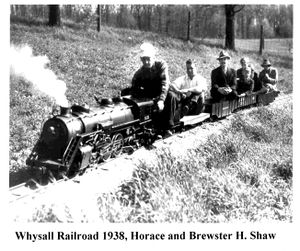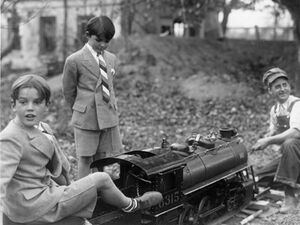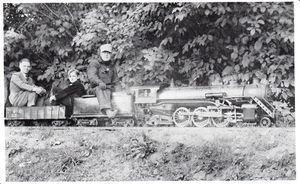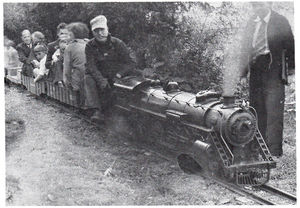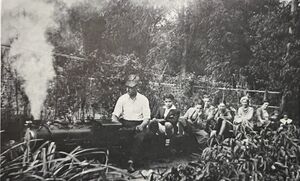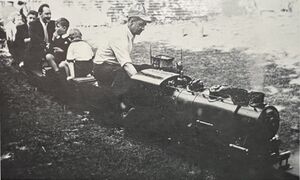Whysall Light Railway
The Whysall Light Railway was a private railroad constructed in the 1930's by Horace P. and Brewster H. Shaw of Bloomfield Hills, Michigan. The railroad was subsequently purchased by Stephen and David Booth and renamed the Tipsico Lakeshore Railroad.
History
From Railroad Magazine, 1939:
- Another midget line in Michigan is the Whysall Light Railway at Bloomfield Hills, whose engines and rolling stock were built as a hobby under the critical eye of Jesse Gall, superintendent of production at Ternstedt plant 16 in Detroit. The WLR is one-quarter of a mile long, with 7-1/4 inch gauge, eight pound mine rails, and a pebble-ballasted roadbed. The locomotive, a live steamer, can haul ten loaded cars at speeds up to thirty miles per hour with no trouble at all.
From Tipsico Lakesore Railroad:
- What was once a dream of brothers Steve and Dave Booth’s in 1935 (top photo) at age 10 and 8, became a reality in 1947 with the purchase of the 7-1/4 inch gauge Whysall Light Railway from Horace P. Shaw. Started in the early 1930’s, Shaw’s railroad had stood idle for many years on his Bloomfield Hills property near what is now the Woodward Avenue entrance to the Cranbrook Educational Community. Absorbed by the railroad bug, Stephen and David, and many enthusiastic volunteers, would labor for the next 15 years to complete a 1/2 mile point to point run.
This is one of the few known photos of Horace Shaw’s Railroad, years before it was purchased by Stephen and David Booth, and renamed the Tipsico Lakeshore. The steam locomotive and All of the cars seen in the photo, are still in use on the TLS today.
The Booth Brothers at Whysall Light Railway in the late 1930's. Is Horace Shaw at the head of the locomotive?
Bill Fitt
Bill Fitt, publisher and editor of Live Steam Magazine, wrote the following in the March 1979 edition:
- Back in July 1937, your Editor-In-Chief was bitten by the Live Steam Bug while running Horace Shaw's 1½ inch scale Pacific in Bloomfield Hills, Michigan, and never fully recovered.
- About a year later, Cliff Pettis, who is currently Vice President of the Southwestern Live Steamers, attended an Open House at Shaw's Whysall Light Railway and took the photos shown here, and was also infected by the smell of coal smoke and cylinder oil. That's Cliffs brother, Hugh, sniffing coal smoke in one photo and sitting in the riding car behind Horace Shaw in the other. Cliff went on to form Texas Railways in Houston, Texas, in 1947 and his patterns and designs were sold later to Robert Miller of Miller Backyard Railroad and thence to Bethlehem Pattern and Model Shop in Pennsylvania. To complete the circuit, they went back to Terry McGrath of the defunct Texas Railway Supply Inc and, as a result, some of these castings show up on just about every 1½" scale track in the country.
- Horace Shaw is still interested, although not active, in the Live Steam Hobby at his home in Bloomfield Hills ... and many of us owe him a debt of gratitude for introducing us to the wonderful world of Live Steam!
Horace Shaw at the throttle on the Whysall Light Railway during an open house in 1938, Bloomfield Hills, Michigan. The young man seated behind the tender is Hugh Pettis, brother of Cliff Pettis. Photo by Cliff Pettis.
Horace Shaw at the throttle, Hugh Pettis stands behind the front of the locomotive. Photo by Cliff Pettis.
Bill Fitt, as editor and publisher of Modeltec, wrote the following in the May 1984 edition:
- Gold Spikes are a long time in becoming reality. For the Union Pacific-Central Pacific, it took six years and four months to the day from ground-breaking ceremonies to completion. For the Lake Meauwataka & Wildwood, it took sixteen years, two-and-a-half months. The Union Pacific-Central Pacific laid 1867 miles of track; the LM&W has about 3400 feet.
- In both cases, the thinking, dreaming and planning took much more time than the actual construction. For the LM&W, the Gold Spike was the culmination of a dream that began in mid-July of 1937 when Horace Shaw, one of the pioneers in inch-and-a-half scale Live Steam, turned over the throttle of his 4-6-2 to young Bill Fitt. The Live Steam Bug bit right then and there and has never relaxed its hold!
- Horace's Whysall Light Railway in Bloomfield Hills, Michigan had about 1200 feet of track that ran from Woodward Avenue back along his property line for a ways before swinging off to the opposite side of his property, down a hill, across a little creek at the bottom of a valley and then back up the other side of the valley to the North property line again. It was an out-and-back operation: running backwards on the "out" run and heading back, locomotive-first, on the return trip. Part way down the hill on the first return run, a cow meandered across the track just ahead of the engine and slowed us enough to cause a stall on the up-grade.
- ...
- In the early 1920's, Horace P. Shaw developed a keen interest in tools and metal work. After making some simple toys and developing his skills, he decided to begin a larger project.
- Exposure to steam locomotives and things mechanical led him to build a 1-1/2 inch scale locomotive and, by 1934, had completed an 0-6-0 and several riding cars. He laid 500 feet of 7-1/4 inch gauge track by the following summer. By 1937 he had extended it to 1200 feet using eight-pound mine rail and completed a 1-1/2 inch scale 4-6-2 and several more cars. Weekends found kids of all ages visiting for a ride.
- Disposition of the 0-6-0 switcher is unknown but, after World War II, he sold the Pacific and the rest of the equipment to Dave Booth who still operates it on his Tipsico Lakeshore Railroad in south-eastern Michigan.
Bill Fitt, as editor and publisher of Modeltec, wrote the following July 1985 editorial:
- There have been many pleasures afforded me over the years as publisher of the Journal for this group of hobbyists. It would be difficult... no, impossible ... to list them or rate any one as more enjoyable than another.
- The one in mind at this moment brings back many happy thoughts and covers quite a span of years. It is Steve Booth's chapter about the Tipsico Lakeshore Railroad that began in the last issue of Modeltec and concludes this month. The 1½ inch scale 4-6-2 #147 that he pictures and describes is the very engine that inflicted this writer with the wonderfully incurable malady we call "Live Steaming," forty-eight years ago!
- That afternoon in 1937 when a dear friend, Grand Trunk engineer Edwin G. Hunsberger, took me around Detroit to see, among other things, the Henry Ford Museum and Greenfield Village, culminated in a visit to Horace Shaw's home in Bloomfield Hills. Who could have known that Horace's offer to let me take the throttle of that miniature locomotive would have brought opportunities, privileges and desires far beyond the wildest dreams of that high-school kid from Muskegon?
- That day has, after many years, brought friends beyond number from every corner of this earth and countless experiences that have helped make this lifetime meaningful and rewarding.
- Horace Shaw gave me my first machine tool... a small wood-working lathe ... and Ed Hunsberger provided the electric motor, very generous gifts in those closing days of the "Great Depres-sion." Both are still in my possession.
- Ed passed away less than ten years after that first trip to Detroit but our contacts and visits with Horace continued until shortly before his death in December 1980.
- It was Horace Shaw who led us to Dave and Steve Booth back in 1964 and their invitation to visit the Tipsico Lakeshore facility and see that 4-6-2 again. It was that visit and that same 4-6-2 that really ignited the glow of Live Steam in our two sons, Chris and Paul, who are both active in The Hobby.
- Two years ago, after a long acquaintance via phone and mail, we met Bill Daney who built the 4-6-2 that started all of this experience. One of Bill's sons (who, I learned is a doctor less than 100 miles from us) brought his mother and father for a much-too-short-visit at Wildwood Farm and which, we hope, reignited his desire for his own Live Steam railroad. Meeting young Doctor Bill Daney led to another discovery that he and Dr. Jim Delevan (one of the surgeons in the group of five and the back-up surgeon for my first heart by-pass surgery ... and a Live Steamer) live less than half-a-mile apart!
- We have learned, too, that our internist in Cadillac, Dr. Jim Sanderson, is also enchanted by the smell of coal smoke and cylinder oil and by stack music. At every turn, it seems, new friends are made and old friends become closer because of the same interests.
- So that 4-6-2 that Steve tells us about still has a profound effect on this man's life along with the lives of many others we have met over the years and, I'm sure, will continue to charm people for years to come!
- wcf
